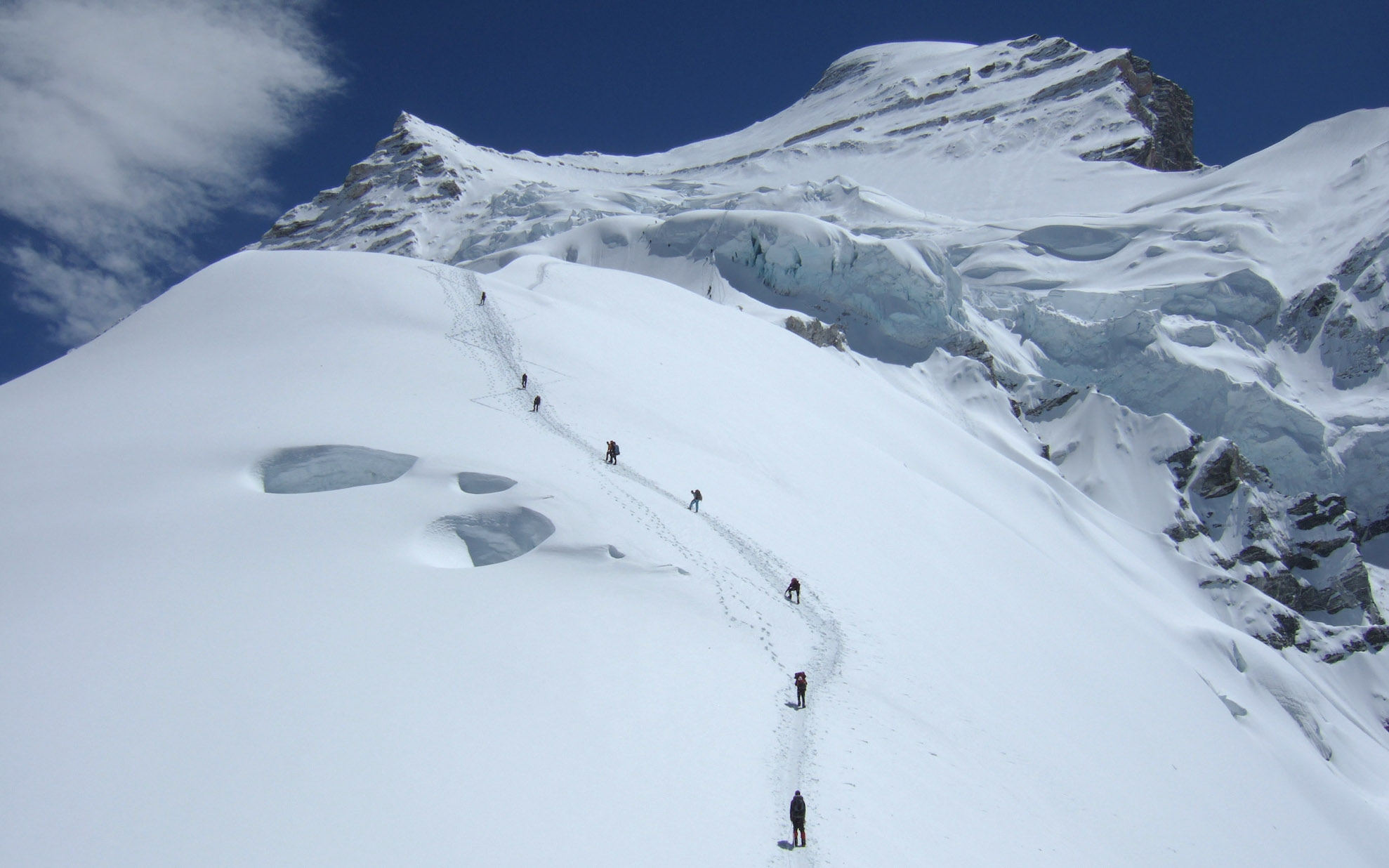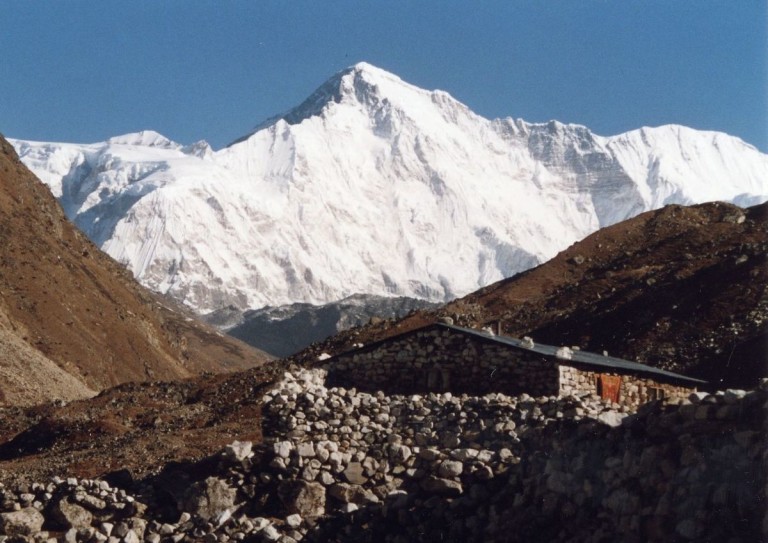- HOME
- Destination
- Adventure Activities
- About Us
- BLOGS
- CONTACT US

Cho Oyu is the sixth-highest mountain of the world that lies in the Himalayas in between the borders of Nepal and Tiber. Cho Oyu means “Goddess of Turquoise.” It is also called “Mighty Head” whose literal meaning is “God’s Head.” Among the 14 peaks with an elevation of more than 8000 meters, Cho Oyu is the easiest mountain to climb in terms of difficulty and death-summit ratio. Cho Oyu has the lowest death to summit ratio among other eight-thousanders.
Cho Oyu falls on the borderline of Nepal and Tibet. The stellar Cho Oyu lies in the Khumbu region of Eastern Nepal and is a neighbor to the tallest peak of the World, the Mount Everest. Cho Oyu lies 20 km west of Everest. The summit gives a panoramic view of all the mountains of Khumbu region like Everest, Nuptse, Ama Dablam, Lhotse, Chamlang, Hungchhi, and Pumori.
You can ascend Cho Oyu through five faces, Northwest, Northeast, Southeast, Southwest and West. The commonly used route is the Northwest ridge through Chinese Base Camp. Mount Cho Oyu also gives birth to a few glaciers. In the north of Cho Oyu, there is Jabula glacier, Lanba and Gecongba glacier in the South.

Image Taken from www.mountainsoftravelphotos.com
The height of Cho Oyu has changed over the years. Initially, the elevation was recorded at 8,150 meters making it the seventh highest mountain at that time after Dhaulagiri (8,167 meters). The Government of Nepal Survey Department and Finnish Meteorological Institute measured the height of Cho Oyu at 8,201 meters. Cho Oyu then moved to sixth highest mountain of the world above Manaslu and Dhaulagiri. Edmund Hillary in his book High Adventure wrote the height of Cho Oyu as 8,189 meters in 1955.
Cho Oyu, the sixth highest peak above sea level of the world is considered as the easiest to climb among all other mountains above 8,000 meters. You can travel to the Chinese base camp in a vehicle and travel to Camp I in hiking boots. There is very few technical ascend and doesn’t have life-threatening ice crevasse and falls. The climb is pretty easy, and climbers with prior experience of scaling peaks of 6000 meters can easily climb to the summit of Cho Oyu.
Trekkers consider Cho Oyu as the perfect stepping stone before attempting an Everest expedition. Cho Oyu is the easiest mountain in the Khumbu region to climb as climbers climb it to get accustomed to climbing at the height of above 8000 meters. Novice mountaineers who haven’t scaled extreme altitudes prefer to climb Cho Oyu before attempting other risky attempts like Everest and Annapurna.
Among the fourteen mountains with elevation above 8,000 meters, Cho Oyu is the second most climbed mountain by mountaineers. Everest takes the first spot of being climbed the most by mountaineers from all over the globe. Despite being dangerous and life-threatening to scale, Everest is the most climbed because of its popularity as the tallest mountain in the world.
Cho Oyu has the lowest death-summit ratio among all the eight-thousanders. The death count per 100 mountaineers who scale Cho Oyu is below 2. In an expedition of about 100 people, only one people die in Cho Oyu, quite a low number count when compared with other mountains above 8,000 meters. Annapurna has the highest death-summit ratio. One in three-person dies when trying to conquer Annapurna.
Despite being the second most climbed and easiest eight-thousander to climb, Cho Oyu has taken lives of more than 200 mountaineers. Many mountaineers have died after a fatal fall when descending. Whenever weather condition worsens on the climb and mountaineers opt to drop quickly, they fall and die of severe damage. Avalanche and Altitude Sickness also takes the life out of many climbers in Cho Oyu.

Image credit: Wikipedia.com
Professional Mountaineers consider Cho Oyu as a trekking peak. The entire summit climb can be completed in about six weeks after landing in Nepal. The direct path and comfortable slopes in the northwest ridge of Cho Oyu make the climb, to a veteran mountaineer, pretty facile.
Mount Cho Oyu expedition dates back to 1952. The Joint Himalayan Committee of Great Britain organised the first Cho Oyu expedition as a practice for Mount Everest expedition. The voyage consisted of Edmund Hillary and Tom Bourdillon and was led by Eric Shipton. The group’s summit push was halted because of danger of avalanche at an ice cliff at 6,650 meters. A report of Chinese troops near the border also influenced Shipton to retreat from Cho Oyu mountain entirely.
The first successful summit climb of Mount Cho Oyu was on 19th October 1954 through the northwest ridge. An Austrian expedition of Herbert Tichy, Joseph Jochler, and Sherpa Pasang Dawa Lama climbed the top of Cho Oyu. Cho Oyu was the fifth mountain above 8,000 meters climbed in the world. The northwest route to the summit of Mount Cho Oyu is named after Herbert Tichy and called Tichy route.
The first death on Cho Oyu was on 28th April 1958. An Indian mountaineer and Indian Army Corps of Engineers, Narendra Dhar Jayal (Nandu) succumbed to altitude sickness. Jayal died because of Pulmonary Oedema caused by overexertion. Nandu had started late and tried to catch the main party in the trek. The death of Narendra signified the need for patience and discipline when scaling the mountains of the Himalayas.
An international all women expedition of Cho Oyu gained worldwide attention in 1959. Claude Kogan, a celebrated French mountaineer, led a women expedition to Cho Oyu, but because of a sudden blizzard in the mountain, four women mountaineers vanished, and their bodies were never found. Brave mountaineers attempt to scale the eight-thousander without oxygen support. Many mountaineers have attempted Cho Oyu without oxygen and completed the summit. Achieving a mountain summit ascend without support of oxygen is physically challenging and praiseworthy.
Over the years, mountaineers have reached the summit of Cho Oyu using three ridges, but the most commonly used route is the Tichy route from the northwest ridge. The entire expedition will take about six weeks minimum. You will reach Chinese Base camp in China which is the gateway to Cho Oyu. Then you trek to Cho Oyu Base Camp just below the north-west face of the mountain. The route above the base camp is sloped until the next base camp.
You will stay at Camp I at 6,400 meters and Camp II at 7,000 meters. The highest camp that can be set up on Mount Cho Oyo is at the height of 7,400 meters. Many mountaineers nowadays complete the summit climb from Camp II. The summit is reached in 7-10 hours from Camp II.
Even though labeled as an easy mountain to scale, you will need to be fully conversant with mountaineering techniques. You must have prior experience of high altitude mountaineering up to 6,000 meters. Mountain climbing is very taxing to the body physically. You need to have a perfect physical condition to scale mountains above 8,000 meters. Also, make sure you have prior winter climbing experience before attempting to scale Cho Oyu.
Some essentials in the Cho Oyo expedition trips are
– Dufflebag, DayPack, Locks and Travel Wallet
– Ice Axe, Crampons, Helmet, Climbing Harness Ascender & Hardware
– Warm Shelled mittens, Plastic Double Boots and over boots
– Glacier Glasses, small repair kit and thermos bottle
– Trekking Poles, Backpack, Pack Cover and Sleeping Bags
– Lightweight Boots, Hiking Boots, Gaiters and Socks
– Clothing(Base layer, Mid Layer), Shell Jacket, Shell Pants & Climbing Pants
– Warm Parka, Trekking clothes and casual wear clothes
– Gloves, Hats, and Buff
– Head Lamp, Water Bottles, WaterTreatment, Camera and Pocket Knife
– Wrist Watch, Eye Wear, Skin Care creams and First Aid Kit
The sheer excitement of scaling mountains above 8,000 meters surely fills you with joy, but your adventure trip has continuously polluted the base camps of mountains like Everest, Cho Oyu, and Annapurna with heaps of garbage. Make sure your expedition is carried out in an eco-friendly manner. Plastic water bottles, food cans, and food wrappers are major pollutants found in the vicinity of base camps.
Future generation also has the right to visit these majestic mountains in their natural condition that is without chunks of garbage littering the environment. You can carry rolls of toilet paper, a pee bag, and a big plastic bag to collect your wrappers and plastic water bottles.
Several cleaning campaigns have been started to clean the basecamps and the trails leading the mountains, to preserve the natural wilderness of the mountains. You can also be a part and help us in keeping the mountains clean and practice sustainable mountaineering for a better tomorrow.
For further queries and information regarding Cho Oyu, you can contact us via Contact Page. You can also ask us your questions about our services, our work experience and any other details you want to know about our past work here.
You can also check information on trekking in Nepal on our blog.
Your email address will not be published.Required fields are marked *
You must be logged in to post a comment.
0 Comments on "Cho Oyu: The Easiest of the Eight-Thousanders"